MILENA DENISSE PICO JÁTIVA
VERÓNICA ALEXANDRA CARVAJAL FLORES
PAOLA BRIGET BONIFAZ DEFAZ (*)
![]() ,
DIANA CAROLINA CALLEJAS PANTOJA
,
DIANA CAROLINA CALLEJAS PANTOJA
![]() ,
,
MILENA DENISSE PICO JÁTIVA
![]() ,
PAOLA MIREYA REGALADO SECAIRA
,
PAOLA MIREYA REGALADO SECAIRA
![]() ,
,
VERÓNICA ALEXANDRA CARVAJAL FLORES
![]()
Universidad de las Fuerzas Armadas ESPE
Av. General Rumiñahui s/n y Ambato,
Sangolquí, Ecuador
*pbbonifaz@espe.edu.ec
RESUMEN
El proceso educativo requiere compromiso y preparación de los docentes para brindar una educación inclusiva que permita el bienestar de los niños/as con Necesidades Educativas Especiales asociadas o no a la discapacidad. El autismo considerado como un trastorno del neurodesarrollo necesita ser diagnosticado en edades tempranas, con el fin de generar una intervención oportuna y pertinente en el ámbito escolar, familiar y social de acuerdo al nivel de severidad, pues cada persona manifiesta sintomatologías diferentes.
Esta condición ha sido aceptada como motivo de inclusión y tema de interés debido a su prevalencia e incremento. El objetivo de la investigación es analizar intervenciones psicoeducativas que comprometen las áreas sociales, emocionales y comunicativas utilizadas en otros países. Frente a esta situación, metodológicamente la investigación es de corte descriptivo-exploratorio, se ha realizado una búsqueda sistemática bajo diferentes parámetros, ecuaciones y códigos de búsqueda que posibilitaron enmarcar estudios dentro de los últimos cinco años.
Recibido: 2021-04-18
Aceptado: 2021-05-18
Los resultados de la investigación se analizan a partir de un cuadro comparativo que expone varias prácticas de intervención psicoeducativas utilizadas. Ecuador ha adaptado metodologías aplicadas en el mundo como procesos de intervención siendo una alternativa de trabajo, el estudio pone en consideración la disciplina consciente como estrategia metodológica para atender a niños/as con autismo, puesto que estimula los procesos de autorregulación mediante el amor y la empatía, fortaleciendo áreas afectadas por el trastorno de neurodesarrollo.
Palabras claves: Autismo, disciplina consciente, programas alternativos, inclusión.
ABSTRACT
The educational process requires teachers’ commitment and preparation to provide an inclusive education that allows the well-being of children with Special Educational Needs, which might be associated or not with disability. Autism is considered a neurodevelopmental disorder, it needs to be diagnosed at an early age in order to generate a timely and pertinent intervention in the school, family, and social environment, based on the level of severity, for each person manifests different symptoms. This condition has been accepted as a reason for inclusion and as a topic of interest because its prevalence and increase. For this reason, psychoeducational interventions used in other countries that compromise the social, emotional and communicative area stand out. However, it seeks to highlight the importance of conscious discipline as an alternative methodology adjusted to the Ecuadorian context and quality of life.
Considering this situation, regarding the methodology, the research type is descriptive-exploratory. A systematic search has been carried out under different parameters, equations, and search codes, which have made it possible to frame studies within the last five years. The results of the research are analyzed from a comparative table that presents the psychoeducational intervention practices used at the global, regional, and local levels. Ecuador has adapted methodologies applied in the world as intervention processes, which are considered a work alternative; however, the study takes into consideration conscious discipline as a methodological strategy to care for children with autism, given that it stimulates self-regulation processes through love and empathy.
Keywords: Autism, conscious discipline, alternative programs, inclusion.
INTRODUCTION
According to the World Health Organization (WHO), “it is estimated that in the world 1 out of 160 children (0.625%) has an ASD” (Lampert, 2018, p.1). Studies have shown that children with Autism Spectrum Disorder (ASD) have difficulties in different areas of their childhood development which is placed according to the level of severity (Tello, 2017), it mainly affects communication, social and emotional areas. “According to the data provided by National Health Statistics Reports, most of children with ASD (58.3%) presents it at a slight level, while 34.8% at a moderate level and 6.9% at a severe one” (Lampert, 2018, p.1).
The prevalence of autism in each country has been increasing, so diagnoses and interventions are tried to be carried out in order to optimize the development and well-being of people with ASD, as the United Kingdom, Spain and Chile have already done. Ecuador, according to the WHO, has registered in 2018 the existence of 1,521 cases, without considering those that have not yet been reported and those that have been erroneously diagnosed (El Telégrafo, 2019). Even when there are ministerial agreements to promote the inclusion of children with Special Educational Needs (SEN), including autism. In Ecuador, there is a long way to go in terms of educational interventions, since discrimination is very notorious and there is no deep awareness about this disability. Zurita (2018) through his writing “Social and Educational Inclusion for Children with Autism Spectrum Disorder”, tries to raise awareness in the Ecuadorian population, aiming to improve the quality of life of these people, in this study he carries out a campaign with the name “Multicolor Blue: A Look at Autism”.
The Ministry of Education (2018) makes the proposal “Pass the word, conscious discipline” that looks for self-regulation of the child based on love, understanding and problem solving. This pedagogical plan is applied to the Ecuadorian educational system, because it has had favorable results (pp.7-12). However, the use of it as an intervention strategy for ASD has not been viewed as a pedagogical or accompanying practice. For this reason, this study tries to relate the affected areas of autism with the abilities, which are going to be stimulated by conscious discipline, becoming this is an alternative of intervention.
OBJECTIVE
The objective of the research is to identify the different psychoeducational interventions that involve autism by reviewing some recent literature, based on conscious discipline as an alternative in educational practice in the Ecuadorian context.
CONCEPTUAL FRAMEWORK
Conceptualization ASD
The theoretical basis of neurodevelopmental disorders considers Special Educational Needs (SEN) that are characterized by deficits in different areas of child development, including among them autism, according to Morrison (2015) DSM-5 “the autism spectrum disorder (ASD) is a heterogeneous neurodevelopmental disorder with highly variable degrees and manifestations that has both genetic and environmental causes ”(p. 26) and” the severity is based on deteriorations of social communication and in restricted and repetitive behavior patterns “(p.28 ).
Areas of affectation.
Autism spectrum disorder is a condition that involves different difficulties in the areas of development. Those most affected ones are: communication, socialization and motor with different degrees of affectation. (Graphic 1)
Graphic 1
Areas of Development involved in Autism
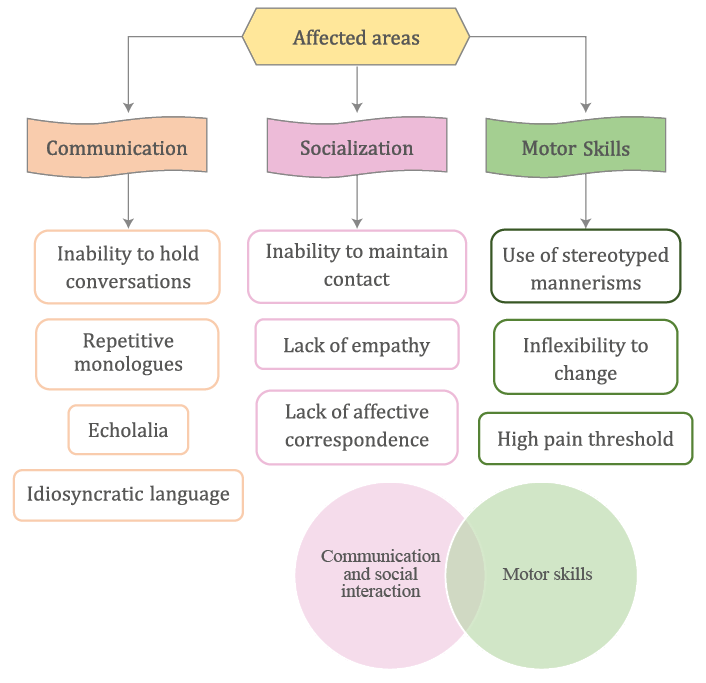
Note. The graph details the difficulties of autism that occur in the different areas of development, based on reviewed researches. DSM-5 relates the first two, because of their similarities. Own elaboration
High impact intervention programs
There are several investigations of alternative proposals and interventions to put them into practice in the educational field, mainly in Europe where there is high interest in the autistic population. “According to a study carried out in the United Kingdom with parents of children with autism spectrum disorder about their experiences with the English educational system, 52% (...) are making progress in their schools” (Lampert, 2018, p 9), due to the use of methods guided by intervention programs. Such is the case of Treatment and Education of Autistic and related Communication-handicapped Children (TEACCH-Treatment and Education of Children with Autism and Associated Communication Problems) implemented in North Carolina and with a spread in 45 American states and different countries around the world. García (2008, as cited in De Goñi Sánchez, 2015) mentions that its purpose is to create structured environments that generalize these learnings to other contexts, preparing people with autism to manage independently in their daily life. The same author points out that “it is based on the organization of space, change of activities through agendas, study and work systems to facilitate the learning process and the organization of the material to stimulate the independence of the student” (p.17).
Applied Behavior Analysis “ABA” is another intervention that tries to extinguish undesirable behaviors through positive reinforcement, “intensive interventions of ABA lead to positive effects on intellectual functioning, language development, acquisition of skills and functioning in the society” (Antuña, 2015, p. 28). It has been outstood for its use in Spain and, also around the world, inasmuch Colombo (2018) highlights that it is the “type of approach that has more research on the spectrum, with more solid results in comparison with other eclectic perspectives and approaches, and it should be considered as the first-choice treatment” (p.14).
Focused intervention programs
In Argentina, there is a high rate of interest so professionals who face the inclusion of children with ASD in the school environment has been prepared, for that reason, Carretero (2019) is mentioned as director of a Postgraduate center that gives opening to the course on Psychoeducational Intervention in Autism Spectrum Disorders in Argentina. Similarly, Mexico carried out a research on: Intervention in a child with autism by playing, written by Moreno (2017) where he shows interest in generating quality intervention programs for this population. Colombia opted for an inclusive initial education, thus having a study carried out at the formal educational institution Gimnasio Campestre Guilford whose results show that “the pedagogical orientations around Autonomy, Self-concept and Self-image must be dealt, since in all three aspects there are children with opportunity of strengthening” (Gutiérrez et al., 2019).
Despite the few regional studies, the ones that has been carried out are about researches that try to improve the situation for people with this condition. There are intervention programs carried out in Spain with good results, as Peris (2015) highlights in his book “Elaboration of an intervention program for the development of socio-emotional competence and improvement of the inclusion in the classroom of a child with Autism Spectrum Disorder”. From those programs we can cite the following: Hanen; focuses on family involvement as the core to optimally care for children with autism.
TEACCH; During the stimulation process the child improves their communication, social and emotional skills, so in “reviewed studies show that the use of the TEACCH methodology not only improves children’s areas of development, but also reduces levels stress from parents and teachers and improves the well-being of adults themselves” Turner-Brown et al. (2016, as cited in Sanz-Cervera, 2018).
Citing another example, there is the EIBI program based on the ABA methodology, “this method consists of breaking behaviors into subcategories, teaching through repetition and positive reinforcement for each subcategory” (Ministry of Health and Social Protection, 2015, p 43) allowing the inclusion in the process of parents, teachers and therapists, achieving coresponsibility for the context that surrounds the infant. Pivotal Response Training (PRT) developed in Scotland, also stands out for the use of the ABA method, it uses operant or behavioral principles based on the child’s restricted interests (Kerry C. M. Gunn, 2015, p. 11). In two writings by Cuesta et al. (2016) “Autism Spectrum Disorder: Educational information and training throughout life” and “Quality of life and Autism Spectrum Disorder” (Vidriales et al., 2017) look for the optimal development of people, the fulfillment of their goals for personal satisfaction and a long-term quality of life, allowing them to be part of an inclusive society. The “Project for environmental structuring in children’s classroom” (PEANA) carried out in Spain, is determined by the use of preferably visual keys, aimed at two fundamental dimensions: space and time management (Tortosa, 2016).
Intervention programs spread in Ecuador
In Ecuador, there is still a long way to go in the inclusion of male and female children with autism, due to little official guidance by a regulatory entity. Several associations focused on Autism have been formed, one of them is the Association of Parents and Friends for the Support and Defense of the Rights of People with Autism of Ecuador (APADA), which provides support to families who have a child. with ASD (Mejillones, 2018). In these institutions, some intervention strategies have been established based on the experiences from other countries, such as the TEACCH and ABA methods. In the study carried out by Mejillones (2018) shows that in APADA there is a basic knowledge regarding the ways of working with these people, 42% of caregivers know or have heard about the TEACCH Method and 25% know the ABA System, but its application is unknown.
Graphic 2
Analyzed intervention programs
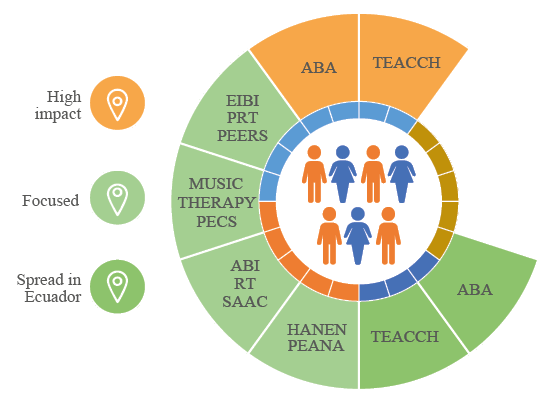
Note. The programs are distributed according to their use around the world. Own elaboration.
Likewise, the director of the Virgen de la Merced Foundation highlights the use of the TEACCH Method for all the benefits it offers (p.47).
Intervention approaches
According to the review of works, this study has framed the different intervention programs into three approaches based on their objectives:
Combined: it includes the participation of all the family, professionals and the community in order to be more effective from an integral perspective, belonging to this approach the TEACCH program (Álvarez et al., 2018).
Psychoeducational: it includes proposals focused on therapeutic, sensory, social, cognitive and behavioral techniques aimed at improving language and behavior. Therefore, the SAAC, ABA, PEERS, ABI and music therapy interventions make up this group as they have objectives focused on communication and behavior Howlin et. al (2009 as cited in Peris, 2015).
Family: it works from the family nucleus to understand the needs of the individual by providing training to them, being part of this approach the Hanen program (Peris, 2015).
Inclusion in the ASD
The Ministry of Education (2018) in the National Model of Management and Educational Attention for Students with Special Educational Needs Associated with Disability of Specialized Education Institutions, mentions as part of its target population the “Psychosocial / mental disability (disorder of the autism spectrum) that present a level of severity grade 2 (Notable help) and grade 3 (Very notable help); Its general objective is to respond to people with disabilities by guaranteeing their rights in Specialized and Inclusive Education institutions ”(p.42).
Because of the above mentioned, this is an attempt by the government to take this population into account in the offer of the national educational system.
Treating children with SEN is a challenge for teachers, who not only have to know about the difficulties that arise from the disorder but they must also concentrate on satisfying their needs and interests that require greater effort and knowledge. The Ministry of Education has regulated the administrative part by establishing that teachers must include children with SEN in regular classrooms and clarifies that for each student with disabilities susceptible to inclusion (grade 1) they will have an equivalent of regular students, “one student with autism is equivalent to five students without disabilities” (Espinoza, 2013, p.6). In the academic part, no formal intervention programs have been established, this makes the teacher feel the need to venture on their own about what methods and strategies they consider most pertinent to deal with this population with disabilities.
A look from the conscious discipline
Conscious discipline or also known as Positive is a set of tools of the program proposed by Dr. Becky Bailey, a specialist in the integral development of children and their education, which is detailed in “Pasa la voz” (Ecuador), it consists on developing socio-emotional skills such as self-regulation, empathy, resilience and trust, through “love and connection instead of fear, as the main strategy”. On the other hand, to understand its significance, Santa Cruz and D’Angelo (2020) cite other authors who affirm that positive discipline is based on 4 pillars and five key principles.
Graphic 3
Principles and pillars of positive discipline
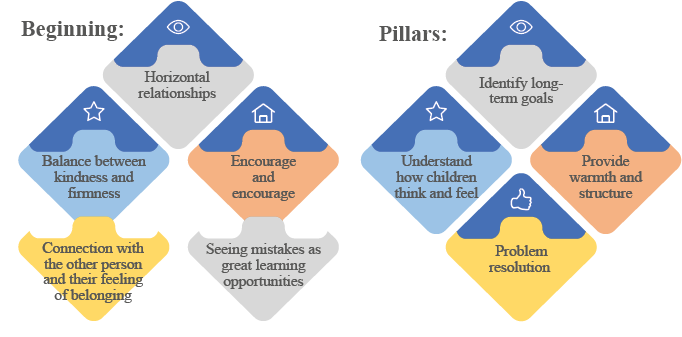
Note. The graphic is made based on what Durren (2013) and Ortega (2014) mention. Own elaboration.
METHOD
The article, which is a descriptive-exploratory research, presents the different educational intervention programs on the autism that exist around the world, and it also tries to highlight the use of conscious discipline as a new intervention alternative.
The descriptors for analysis used in here were those research works on the subject found in journals such as Dialnet, Scielo, Research Gate, Educational Psychologists and university repositories, as well as Google Scholar. Similarly, the Gavilán Model was considered, thus carrying out 15 search equations under the criteria of the last five years of publication.
From the investigations found, an Excel matrix was made that facilitated the systematization and a second selection of pertinent information to be cited in the study, establishing the following parameters: year of publication, name of the article, translation, author, date of search, link, magazine, language, abstract, discussion or conclusion. Subsequently, each of the themes found was analyzed, highlighting similarities in terms of characteristics and results for the validity of the psychoeducational intervention programs, (table No. 1). Regarding to conscious discipline, the relevant ideas of each selected study were descriptively synthesized, in order to compare the development areas that it involved in correspondence to autism, to finally draw conclusions.
RESULTS
The various intervention programs demonstrate the impact that treatments have on the progressive development of skills affected by ASD based on their results in experimental studies. In this way, the present research stands out relevant achievements based on quantitative data, such as:
Torró (2012) in his analysis of the ABA program indicates that in 508 studies, the 70% of the results have been beneficial, 2% have been ineffective, 28% are unknown and there have been no results in which children have received any damage or harm due to the program (p. 18). On the other hand, the TEACCH program in Spain, shows in several studies the effectiveness of the interventions, the 80% of the parents valued the results positively according to the Ministry of Sciences and Innovation (2009). SAAC shows that the 18.19% from 11 studies have used the method to reduce challenging behaviors and its effectiveness has been 100%, the participants reflect improvements in communication and communicative intention, that is an increasing in the number of social interactions (Martin, 2018, pp. 16-17).
There are also other programs with the intention of more focused professional interventions, which lead to a dispersion in terms of application in different contexts. The PEERS, PECS, ABI and PEANA programs are in studies of conceptualization that, despite they have obtained some favorable results, these are limited studies, so they recommend carrying out more indepth and experimental investigations to obtain information regarding the area of development involved in each intervention (Sanz-Cervera, 2018). Following this line, HANEN in his study aimed at 3 children and another work aimed at a sample of 51 infants getting favorable results in terms of vocabulary, the RT program analyzes 13 children who are candidates for the diagnosis of ASD and in another a sample of 20 subjects, with the purpose to know the socio-emotional functioning. On the other hand, music therapy is only framed in case studies, without major significant results.
Table 1
Analysis of Outstanding Intervention Programs.
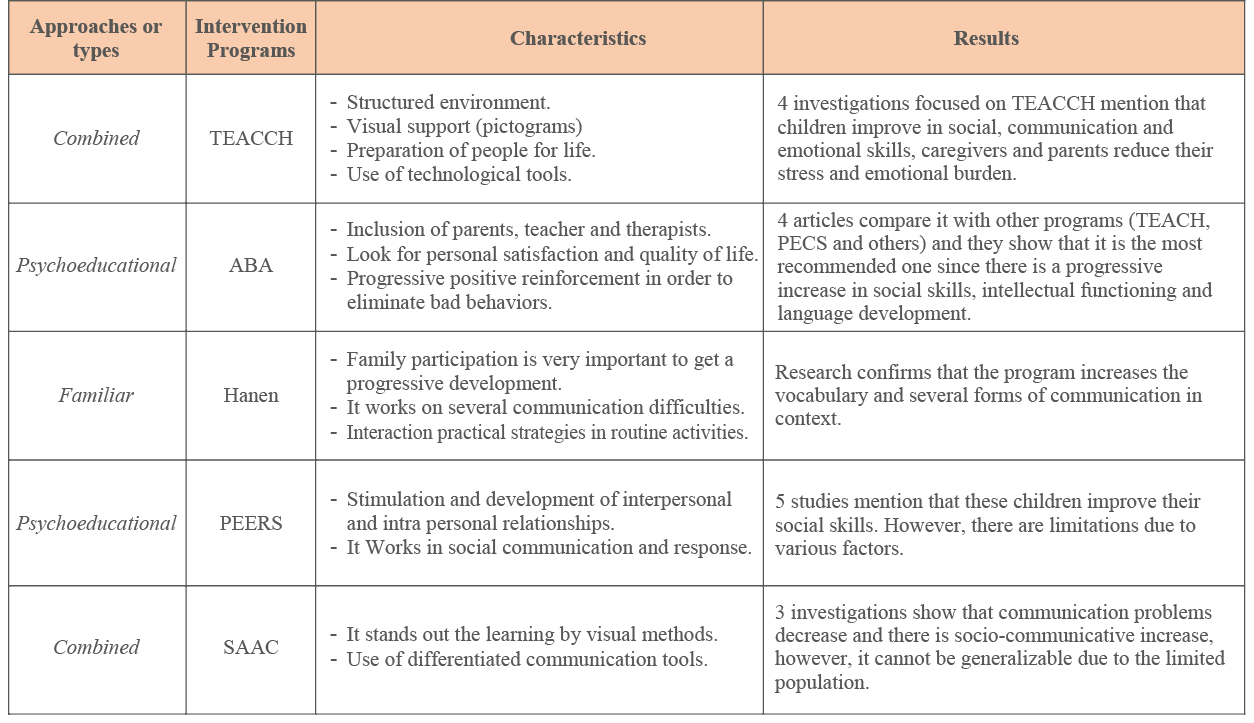
Note. This table shows the number of investigations, stands out their results and the characteristics of the main programs for children with autism.
These synthesized data of the diversity of programs show that the studies are minimal in terms of the sample considered for each research work, due to the characterization of autism and the symptoms it presents.
The foregoing makes it possible to mention the scarce generalization of intervention programs, since they must be adapted to each country and to the levels of severity of autism.
According to the findings about educational intervention programs for ASD, there have been several attempts to optimize the education of these children in order to improve the quality of life and integrate them into society, as Cuesta mentioned, et al. (2016) “The programs, and therefore the intervention, will be aimed at promoting personal development in all areas of daily life. His planning will focus on getting achievements that are relevant in the life of the person”. (p. 159)
On the other hand, conscious discipline can be an alternative to treat in children with autism because of the principles and pillars that this methodology works based on respect and empathy for the other. In addition, it is in the same line of TEACCH when it comes to making the culture of autism known to relatives and infants who are mates of the child with ASD in a structured way. Like, SAAC and PECS at the moment of starting a spontaneous social interaction and communication within the framework of understanding and love. These similarities to conscious discipline give way to its consideration as an alternative method. The use of state-of-the-art methodologies reflects the disuse of traditional methods that according to Santa Cruz and D’Angelo (2020) mention that they provoke aggressive behaviors, emotional deficiencies (anger, resentment, sadness and fear), escape behaviors, imitation and continuous use of punishment (pp. 60-61). Paraphrasing the same author, the use of conscious discipline is a reliable option to generate a feeling of belonging, self-discovery, autonomy, and mutual respect. These fundamental aspects in students´ lives, in addition to the participation of the family context, are a key element for the progressive development of the areas to be stimulated, since it is “unlikely that positive discipline will be successful if children face a set of expectations and rules at school and a completely different set at home” (Center for Justice and Crime Prevention, 2012, p. 9).
Graphic 1
Relationship of conscious discipline and the areas affected by autism

Note. The graphic details how the developmental areas affected by autism can be addressed with the social-emotional skills that conscious discipline addresses. Own elaboration.
In Ecuador, there are studies and some investigations as new proposals, one of them is, the Competency Development Model to achieve the progress of the effective capacities in children with ASD, it tries to adapt conscious discipline strategies to work in an inclusive context within a regular classroom (Vargas, Pucha, & Morillo, 2019, p. 23); however, this study does not have quantitative results. Similarly, the San Francisco de Quito University in its transversal research entitled “Positive discipline an educational method for preschool children with ASD, autism spectrum disorder” (Alarcón, 2019).
This study is in application and its favorable results are expected in the emotional, social, and educational aspects. Despite these efforts, López and Larrea (2017) in their pioneering study entitled “Autism in Ecuador: A social group awaiting attention” stands out that the deficiencies in the diagnosis are a barrier to inclusion because in 161 schools in Quito “36% of the schools believe that there is at least one child who has not had an ASD diagnosis” (Pazmiño and Zurita, 2018, p. 43). The results of this research show figures regarding insertion in schools, showing that 58% have had negative experiences, due to rejection, misunderstanding and isolation, and this is a common experience.
DISCUSSION AND CONCLUSIONS
The differences of autistic children have given a path to develop studies for the implementation of intervention programs around the world, several of them have had positive responses and each one presents different intervention approaches because of the nature of the cases and the context. Around the world, the TEACCH intervention program with a combined approach that includes the family and the use of technological tools as part of the process, involving the structuring of space and the organization of time with the support of visual information, has enable personalized attention to the particular needs of male or female children with ASD in a regular education setting, TurnerBrown et al. (2016, as cited in Sanz-Cervera, 2018). TEACCH has some similarity to the SAAC communication intervention program that emphasizes visual learning. Several investigations show great success in their applications, García and Sánchez (2000, as cited in Mira and Grau, 2017) affirm that “in the case of students with ASD, the Total Communication system is one of the most used and with the best results according to evidence based on practice ”(p. 116),
also, Chile in an investigation (González et al., 2017) carried out on parents of children with autism spectrum comment that there was great improvement in the social and communication areas of their children after using SAAC as an intervention method, it also allowed them to know their needs and be able to satisfy them.
The ABA program focuses its focus on behavioral intervention. Colombo (2018) in his writing “ABA in the treatment of autism”, presents a historical tour and analysis of research that studies the influence of this program around the world, and it was found that: In 2009, the National Autism Center produced an analysis of 22 investigations about the ABA program and it was determined that early intervention is solid and successful for disability. In the same way, Peters et al. (2011, as cited in Colombo, 2018) tries to measure the effectiveness of the program based on 11 investigations that found that children with ASD successfully overcame various areas of development (pp. 11-12). In this way, it is determined that the guided intervention with the ABA program favors the quality of life, in addition family is included, this is an alternative that can be improved as it is carried out in different countries and is adapted to their realities.
Meanwhile, Hanen bases his program on family participation context. Within the research by Pérez and Arróniz (2018), it is analyzed the studies by Girolametto, Sussman, and Weitzman (2007) as well as McConachie et al. (2005), and it is established that this program is relied on the interest and parent intervention, managing to expand the vocabulary of children with ASD, unlike PEERS, which is aimed at interpersonal and intrapersonal relationships. On the other hand, a study carried out at the University of Valencia stands out music therapy as a sensory-motor intervention program to work with children with autism.
In the same study Calleja, Sanz and Tárraga, (2016) mention that “11 out of 18 interventions obtained significant improvements (…), while in the remaining 7 interventions, either the improvement did not reach statistical significance or there is some kind of limitation regarding the effectiveness of the intervention” (p. 152). Therefore, it is necessary to rethink the methodological adaptations to improve music therapy activities in ASD. Like this one, the PECS, ABI, RT, PEANA programs require more research with statistical data and considerable samples that express their reliability as treatments for ASD.
The particularities of autism are manifested as challenges for the social context, due to the symptoms that occur according to the level of severity. This fact gives way to the need for appropriate and adapted interventions according to their characteristics based on a reliable diagnosis. Most research shows that the peculiarities of autism are focused on various areas of development. The situation in Ecuador is a topic of discussion, López and Larrea (2017) establish that the 26% of the children in a study group received between 1 to 5 different previous diagnoses, 13.75% were misdiagnosed, 46.2% in Guayaquil and 23.7% in Quito. These author spent more than $ 1000,oo USD trying to get the longed-awaited diagnosis. According to the WHO, in 2018, the existence of 1,521 cases has been registered, without taking into account those that have not yet been reported and those that have been erroneously diagnosed (El Telégrafo, 2019)
This situation should be a matter of interest for the corresponding organizations or entities, starting with the collection of data about the disabilities that exist in the Ecuadorian population and in this way to comply with the robust legal framework that was implemented in order to improve the quality of life of these people.
This will lead to the generation of studies of alternative methodologies for the educational field from reliable diagnoses or also to the adaptation of existing programs such as the case of Conscious discipline proposed by Dr. Becky Bayley, which has been globally applied up to now without having specifications for male or female children with ASD. The technical-pedagogical support guide from Ministry of Education.cl (2016) refers to the characteristics of qualitative alteration, social interaction, communication, behavior patterns, interests and restricted, repetitive, and stereotyped activities as a basis for the Skills approach. In this way, Simons and Tupiño (2019) in their writing about teaching strategies based on Conscious discipline for the inclusion of children with ASD, consider these activities as a necessity to meet the objectives. Another point to consider is the pedagogical practices of the TEACCH and ABA intervention programs that have been adapted by institutions, associations, or organizations dedicated to working for the well-being and improvement of people with autism despite the little knowledge they have regarding their application. This aspect demonstrates the need to professionalize those intervention practices.
Hence, in addition to analyzing the strategies used by positive discipline so they will be the support in the inclusion of children with autism, it is necessary to generate studies that quantitatively demonstrate the benefits of its applicability. Even when there are agreements of the Ministry of Education regarding educational inclusion, the implementation and adaptation of alternative methodologies such as pedagogical practices for children with autism in regular classrooms, depends on each educational center, in the same way the teacher training in the country needs to be included in the curriculum subjects that deal with special educational needs focused on disabilities such as autism, in order to generate specialized educational spaces in this neurodevelopmental disorder.
REFERENCES
Alarcón Moncayo, V. (2019). La “disciplina positiva” un método
educativo para niños preescolares con TEA, trastorno
espectro autista. Repository of the San Francisco de Quito
University USFQ, 69.
Álvarez, R., Franco, V., García, F., García, A. M., & Giraldo,
L. (2018). Manual didáctico para la intervención en la
atención temprana en trastorno del espectro autismo.
Obtained from http://www.autismoandalucia.org/wpcontent/-uploads/2018/02/MANUAL-AT-DEF.pdf
Antuña Cerredo, B. (2015). Aprendizaje de habilidades sociales y
enseñanza específica de interacciones sociales en niños con
autismo y síndrome de Asperger: respuestas flexibles y emergencia
de nuevas habilidades de comunicación. Dialnet, 191.
Baptista Lucio, M. d., Hernández Sampieri, R., & Fernández
Collado, C. (2014). Metodología de la Investigación.
México: MC GRAW HILL Education.
Calleja-Bautista, M., Sanz-Cervera, P., & Tárraga-Mínguez, R.
(2016). EFECTIVIDAD DE LA MUSICOTERAPIA EN EL
TRASTORNO DE ESPECTRO AUTISTA: ESTUDIO DE
REVISIÓN . Redalyc, 152-160.
Carretero, M. (2019). Curso de Posgrado Intervención
psicoeducativa en trastornos del espectro autista Argentina.
Obtained from FLASCO ARGENTINA: https://www.
aprendizaje.flacso.org.ar/intervencion-psicoeducativa
Centre for Justice and Crime Prevention. (2012). Positive Discipline
and Classroom Management. Research Gate, 50.
Colombo, M. (Febrero de 2018). ABA en el Tratamiento del
Autismo. Obtained from Psyciencia: https://pavlov.
psyciencia.com/2018/02/aba-tratamiento-autismo.pdf
Confederación del Autismo-España . (2017). Calidad de vida y
Trastorno del Espectro del Autismo. España: Confederación
Autismo España. Obtained from http://www.autismo.org.
es/sites/default/files/calidad_de_vida_y_tea_coleccion_
calidad_de_vida_web.pdf
Cuesta, J., Sánchez, S., Orozco, M., Valenti, A., & Cottini, L.
(2016). Trastorno del espectro del autismo: intervención
educativa y formación a lo largo de la vida. Obtained
from Psychology, Society and Education: https://reunir.
unir.net/bitstream/handle/123456789/3448/PERIS%20
GARCIA%2C%20JAUME.pdf?sequence=1&isAllowed=y
De Goñi Sánchez, A. (2015). Repositorio de la Universidad
de Navarra. Obtained from EL MÉTODO TEACCH
EN EDUCACIÓN INFANTIL: https://dadun.unav.edu/
bitstream/10171/39649/1/ADRIANA%20DE%20
GO%C3%91I.pdf
El Telégrafo. (26 de octubre de 2019). “Más de 1.500 personas en Ecuador viven con autismo”. Obtained from https:// www.eltelegrafo.com.ec/noticias/cartas/1/autismo- ecuador-salud#:~:text= %E2%80%9CM%C3 %A1s%20 de%201.500 %20personas %20en %20Ecuador %20 viven %20con %20autismo%E2 %80%9D,-26%20 de%20octubre&text= Seg %C3%BAn %20la%20 organizaci%C3%B3n %20Mundial%20de,o%2 0han%20s
Espinoza, A. (2013). Ministerio de Educación. Obtained
from Acuerdo Ministerial 0295-13: https://educacion.
gob.ec/wp-content/uploads/downloads/2013/08/
ACUERDO_295-13.pdf
González Peña, C., Ruiz Salazar, C., María Machuca, J. S.,
Sepúlveda Rain, J., & Uribe Villablanca, N. (09 de octubre
de 2017). PERCEPCIÓN DE PADRES DE ESTUDIANTES
CON TRASTORNOS DEL ESPECTRO AUTISTA SOBRE EL
USO DE SISTEMAS ALTERNATIVOS Y AUMENTATIVOS
DE COMUNICACIÓN DE LA ESCUELA DIFERENCIAL
Y CENTRO TERAPÉUTICO ASPAUT DE LA COMUNA
DE CHIGUAYANTE. Obtained from Catholic University
of the Holy Conception:http://repositoriodigital.
ucsc.cl/bitstream/handle/25022009/1245/
Cecilia%20Gonz%C3%A1lez%20Pe%C3%B1a.
pdf?sequence=1&isAllowed=y
Gunn, K., & Delafield-Butt, J. (2016). Teaching Children With
Autism Spectrum Disorder With Restricted Interests: A
Review of Evidence for Best Practice. Review of Educational
Research, 1-23.
Gutiérrez Beltrán, Y., Patarroyo Sánchez, L., Rincón Infante, S. M.,
& Blanco Vega, M. d. (2019). El rol del pedagogo infantil
en procesos de inclusión- Fortalecimiento de la expresión
emocional en. Dialnet, 10
Kerry C. M. Gunn, J. T.-B. (2015). Teaching Children With
Autism Spectrum. Review of Educational Research, 408-
430. doi:Gunn, K. C. M., & Delafield-Butt, J. T. (2016).
Teaching Children With Autism Spectrum Disorder
Wi10.3102/0034654315604027
Lampert -Grassi, M. P. (2018). Trastorno del Espectro Autista.
Epidemiología, aspectos psicosociales, y políticas de apoyo
en Chile, España y Reino Unido. Library of the National
Congress of Chile, 29.
Larraceleta González, A. (2017). INTERVENCIONES
FOCALIZADAS BASADAS EN LA EVIDENCIA DIRIGIDAS
AL ALUMNADO CON TRASTORNO DEL ESPECTRO
AUTISTA. Ministry of education, culture and sports of the
Principality of Asturías, 73-87.
López Chávez, C., & Larrea Castelo, M. d. (2017). Autismo
en Ecuador: Un grupo social en espera de atención.
Scielo, 12.
Luis Martin, P. (2018). Uso del SAAC en el Autismo, una revisión
bibliográfica. Downloaded from University of La Laguna:
https://riull.ull.es/xmlui/bitstream/handle/915/14598/
Uso%20de%20SAAC%20en%20el%20autismo.
pdf?sequence=1&isAllowed=y
March-Miguez, I., Montagut-Asunción, M., Pastor-Cerezuela,
G., & Fernández-Andrés, M. I. (2018). INTERVENCIÓN
EN HABILIDADES SOCIALES DE LOS NIÑOS CON
TRASTORNO DE ESPECTRO AUTISTA: UNA REVISIÓN
BIBLIOGRÁFICA. Dialnet, 140-149.
Ministerio de Ciencias e Innovación. (2009). Evaluación de
la eficacia de las intervenciones psicoeducativas en los
trastornos del espectro autista. Madrid: IIER.
Mejillones, R. A. (2018). “Desarrollo de material gráfico,
educativo e informativo para la APADA (Asociación de
Padres y Amigos del Autismo) para aportar al desarrollo
de la autonomía de las personas con trastorno de espectro
autista en casa. Downloaded from PONTIFICAL CATHOLIC
UNIVERSITY OF ECUADOR: https://www.google.com/
url?sa=t&rct=j&q=&esrc=s&source=web&cd=&cad=rj
a & u a c t = 8 & v e d = 2 a h U K E w j f r e 7 U
8 9 v v A h U p U 9 8 K H Z q C A p s Q F j A A e g
QIAxAD&url=http%3A%2F%2 Frepositorio.puce.edu.
ec %2Fhandle%2F22 000%2F14835&usg=AOvVaw1-
b8OkXlrGx2wejHp5S_gI
Ministerio de Educación. (abril de 2018). Obtained from
Disciplina Consciente Cambias Tú y Cambia el Mundo
Parte 2: https://educacion.gob.ec/wp-content/uploads/
downloads/2018/03/PASA-LA-VOZ-marzo.pdf
Ministerio de Educación. (marzo de 2018). Educación.gob.ec.
Obtained from Pasa la voz : https://educacion.gob.ec/
wp-content/uploads/downloads/2018/03/PASA-LA-VOZmarzo.pdf
Ministerio de Educación. (2018). Modelo Nacional de Gestión
y Atención Educativa para Estudiantes con Necesidades
Educativas Especiales Asociadas a la Discapacidad de
las Instituciones de Educación Especializadas. Obtenido
de https://educacion.gob.ec/wp-content/uploads/
downloads/2018/07/Modelo-IEE.pdf
Ministerio de Educación de Chile (MINEDUC). (2016). Guía
de Apoyo Técnico- Pedagógico: Necesidades Educativas
Especiales en el nivel de educación Parvularia. Santiago de
Chile: Editorial Atenas Ltda.
Ministerio de salud y protección social. (Marzo de 2015).
PROTOCOLO CLÍNICO PARA EL DIAGNÓSTICO,
TRATAMIENTO Y RUTA DE ATENCIÓN INTEGRAL DE NIÑOS
Y NIÑAS CON TRASTORNOS DEL ESPECTRO AUTISTA.
Obtained from https://www.minsalud.gov.co/sites/rid/Lists/
BibliotecaDigital/RIDE/DE/CA/Protocolo-TEA-final.pdf
Mira Pastor, R., & Grau, C. (2017). Los sistemas alternativos y
aumentativos de comunicación (SAAC) como instrumento
para disminuir conductas desafiantes en el alumnado con
TEA: estudio de un caso. Spanish Journal of Disability,
113-132.
Moreno, C. X. (2017). Intervención en un niño con autismo
mediante el juego . Obtained from http://www.scielo.org.
co/pdf/rfmun/v66n3/0120-0011-rfmun-66-03-365.pdf
Morrison, J. (2015). DMS-5 Guía para el diagnóstico clínico.
México: Editorial El Manual Moderno, S.A. de C.V. .
Pazmiño Torres, M. V., & Zurito Cadena, C. A. (2018). Inclusión
Social y Educativa para Niños con Trastorno del Espectro.
Google Scholar, 127.
Pérez, B., & Arróniz, L. (2018). Alternativas de tratamiento en los
trastornos del espectro autista: una revisión bibliográfica
entre 2000 y 2016. Obtained from Journal of Clinical
Psychology with Children and Adolescents: http://www.
revistapcna.com/sites/default/files/3_1.pdf
Peris, J. (2015). Elaboración de un programa de intervención para
el desarrollo de la competencia socio- emocional y mejora de
la inclusión en el aula de un niño con Trastorno del Espectro
Autista. Obtained from Google Scholar: https://reunir.
unir.net/bitstream/handle/123456789/3448/PERIS%20
GARCIA%2C%20JAUME.pdf?sequence=1&isAllowed=y
Santa Cruz, F. F., & D’Angelo, G. (2020). Disciplina positiva para
el desarrollo de las habilidades emocionales. Scielo, 53-73.
Sanz-Cervera, P. (2018). El trastorn de l’espectre autista i les
aules de comunicació i llenguatge. Dialnet, 340.
Simons Pizarro , P. R., & Tupiño Contreras, L. B. (2019). Propuesta
de estrategias docentes basadas en disciplina positiva para
la inclusión de niños con TEA en un aula del ciclo II de
Educación Inicial. PUCP Digital Repository, 66.
Tello Ojeda, M. d. (2017). El uso de los Recursos Didácticos
utilizados por los docentes del CEBE FAP OMG en la
enseñanza de habilidades comunicativas a los niños con
Trastorno del Espectro Autista en el área de Comunicación.
Scielo, 116.
Torró, S. (2012). Evidencia experimental de eficacia de los
tratamientos globales. Scielo, 80.
Tortosa , F. N. (2016). INTERVENCIÓN EDUCATIVA EN EL
ALUMNADO CON TRASTORNOS DEL ESPECTRO
AUTISTA. Obtained from http://www.psie.cop.es/uploads/
murcia/Intervenci%C3%B3n%20TEA.pdf
Vargas Castro, K. V., Pucha Cango, R. T., & Morillo Carrión, J.
L. (2019). Estrategias en disciplina positiva y su incidencia
en la inclusión educativa de niños y niñas con trastorno
del espectro autista en educación inicial. UNEMI Digital
Repository, 43.
Vidriales Fernández, R., Hernández Layna, C., Plaza Sanz, M.,
Gutiérrez Ruiz, C., & Cuesta Gómez, J. L. (2017). Calidad
de vida y Trastorno del Espectro del Autismo. Spain: Autism
Confederation Spain.
Zurita, M. P. (2018). Inclusión Social y Educativa
para Niños con Trastorno del Espectro Autista.
Obtained from https://repositorio.usfq.edu.ec/
bitstream/23000/7369/1/137689.pdf
BIOGRAFÍA DE LOS AUTORES
 Paola Bonifaz D.
Paola Bonifaz D.
Egresada de la Carrera de Educación Inicial en la Universidad de las Fuerzas Armadas “ESPE” con experiencia laboral de 3 años como docente de apoyo en Educación Inicial y Maternal en las instituciones: Centro de Desarrollo Infantil “Sweet Steps”, Centro de Desarrollo Infantil “Mis Primeros Amigos”, Unidad Educativa Particular “Hans HIllmann”, Unidad Educativa “Santo Domingo”. Tendencia a temas de investigación relacionados al Autismo y el Desarrollo Evolutivo del infante. A partir del mes de septiembre del 2021 se ha desempeñado como docente titular de niños con TEA grado 2 de Educación Inicial I en el Centro de Rehabilitación neurológica “CERENI”.
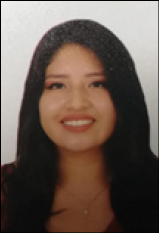 Milena Pico J.
Milena Pico J.
Egresada de la Carrera de Educación Inicial en la Universidad de las Fuerzas Armadas “ESPE” con experiencia laboral de 3 años como docente de apoyo en Educación Inicial y Maternal en las instituciones: Centro de Desarrollo Infantil “Sweet Steps”, Centro de Desarrollo Infantil “Mis Primeros Amigos”, Unidad Educativa Particular “Hans HIllmann”, Fundación “Aliñambi”. Tendencia a temas de investigación relacionados al Autismo y el Desarrollo Evolutivo del infante. A partir año del 2022 se ha desempeñado como docente de apoyo de niños con TEA grado 2 de Educación Inicial I en el Centro de Rehabilitación neurológica “CERENI”.
 Paola Regalado S.
Paola Regalado S.
Egresada de la Carrera de Educación Inicial en la Universidad de las Fuerzas Armadas “ESPE” con experiencia laboral de 3 años como docente de apoyo en Educación Inicial y Maternal en las instituciones: Centro de Desarrollo Infantil “Sweet Steps”, Centro de Desarrollo Infantil “Mis Primeros Amigos”, Unidad Educativa Particular “Hans HIllmann”, Fundación “Aliñambi”. Tendencia a temas de investigación relacionados al Autismo y el Desarrollo Evolutivo del infante. A partir del mes de septiembre del 2021 se ha desempeñado como docente titular de niños con TEA grado 2 de Educación Inicial II en el Centro de Rehabilitación neurológica “CERENI”.
 Carolina Callejas P.
Carolina Callejas P.
Estudiante de la Carrera de Educación Inicial en la Universidad de las Fuerzas Armadas ESPE. Con experiencia laboral como auxiliar de Inicial en las instituciones: Centro de Desarrollo Infantil “María Teresa Lee” y en la Unidad Educativa “Juan de Salinas”. Inclinación investigativa en temas relacionados con la práctica pedagógica ejecutada en el contexto del autismo.
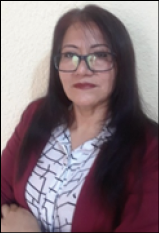 Verónica Carvajal
Verónica Carvajal
Docente titular de la Universidad de las
Fuerzas Armadas ESPE. Profesional con
Licenciatura en Educación Parvularia, Doctorado de 3er nivel en Investigación y Planificación Educativa,
Maestría en Intervención
a las Dificultades del Aprendizaje, su formación la ha complementado con cursos de
especialidad en Neuropsicología, Neuroeducación, Integración Sensorial, Educación
Inclusiva, Facilitadora Familiar Sistémica,
con más de 25 años de experiencia en: Educación Inicial, Preparatoria, E. G. Básica - Elemental, Básica
Superior y Educación
Universitaria, ha desempeñado cargos como Directora y Coordinadora Pedagógica de Inicial, Preparatoria y
Básica Elemental
en “La Salle” - Conocoto 1997 - 2014, en el 2007 Miembro de
Comisión Pedagógica a nivel nacional de las instituciones del
Distrito de La Salle en el Ecuador, 2014 parte del equipo de Acreditación Institucional – “La Salle” -
Conocoto. Asesora Psicopedagógica de Proyecto Educativo de la Municipalidad de Otavalo
en el año 2019 y desde 2008 hasta la actualidad Psicopedagoga
del Centro “Comunicare”.
A partir de 2014 se ha desempeñado como docente de la carrera de Educación Inicial, 2015 ha desempeñado
cargos como:
Miembro del Equipo de Rediseño Curricular de la carrera de
Educación Inicial, 2016 responsable del equipo de Acreditación
Institucional del Departamento de Ciencias Humanas y Sociales,
Miembro de Consejo de Carrera Educación Inicial, Educación
Infantil, y del DCHS, a partir del 2018 Coordinadora de área de
conocimiento Pedagogía – Psicología, actualmente Coordinadora de área de Psicología.
Sus intereses de investigación son: Educación Inclusiva, Tecnología y Educación, Innovación - Planificación
Curricular y Políticas
públicas.